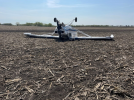- Joined
- Mar 15, 2016
- Messages
- 4,898
- Display Name
Display name:
Ari
Accident Piper PA-22 Tri-Pacer N669A,
The aircraft sustained substantial damage subsequent to an impact with open field terrain near Enderlin, North Dakota. The pilot sustained minor injuries, and two passengers were not inju...
aviation-safety.net
It sounds like the engine failed, the pilot landed in a field, and the plane attempted a somersault. Pilot plus two children on board. The pilot had minor injuries and the children were uninjured.


